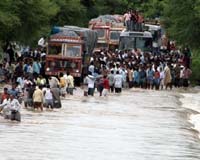 |
New Delhi, India (RIA Novosti) Sep 08, 2009 India's first lunar mission may have failed as a result of overheating, a national daily reported on Monday. Chandrayaan-1 was launched in October 2008 and its main mission was conducting geological mapping of the Moon's surface aimed at producing a complete map of the chemical characteristics and 3-D topography. Chandrayaan means Moon Craft in Sanskrit. According to The Times of India, Chandrayaan's orbit around the Moon was raised up to 200km (124 miles) from 100km (62 miles) earlier in May this year because of a blunder in calculating the Moon's temperature that led to a faulty thermal protection. The paper quoted Dr. T. K. Alex, director of the satellite center at the Indian Space Research Organization, as saying that it had been assumed the temperature at 100km above the Moon's surface would be around 75 degrees Celsius (167 Fahrenheit). "However, it was more than 75 degrees and problems started to surface. We had to raise the orbit to 200km." The paper said heating problems on the craft had begun last November, forcing some of the payloads to deactivate. In early 2009, the orbiter's two star sensors started malfunctioning and then failed because of high temperatures. The sensors are crucial in determining the orientation of the craft in space. The project was terminated on August 30, when communication with the spacecraft suddenly failed, although 95% of the scientific aims had been accomplished, according to space officials. Despite the failure, Chandrayaan-1 managed to transmit excellent images including that of the solar eclipse on July 22.
Source: RIA Novosti Share This Article With Planet Earth
Related Links ISRO Space Technology News - Applications and Research
 Satellite Being Designed To Connect Villages
Satellite Being Designed To Connect VillagesKochi, India (PTI) Sep 08, 2009 The Indian Space Research Organisation is in the process of designing a satellite for providing connectivity to villages, ISRO Chairman G Madhavan Nair said Friday. "We have plans to use multiple spot beams for the satellite, which is expected to be launched in another two and a half years time," Nair told reporters here in southern Indian state of Kerala. There are about 600,000 ... read more |
|
| The content herein, unless otherwise known to be public domain, are Copyright 1995-2009 - SpaceDaily. AFP and UPI Wire Stories are copyright Agence France-Presse and United Press International. ESA Portal Reports are copyright European Space Agency. All NASA sourced material is public domain. Additional copyrights may apply in whole or part to other bona fide parties. Advertising does not imply endorsement,agreement or approval of any opinions, statements or information provided by SpaceDaily on any Web page published or hosted by SpaceDaily. Privacy Statement |